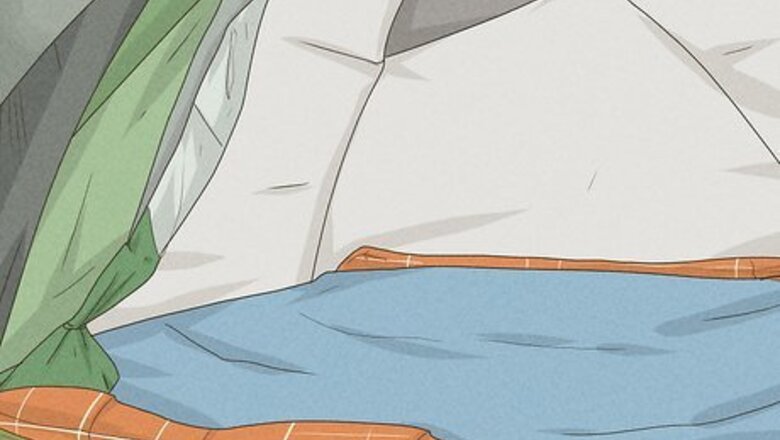
views
Insulate your tent.

Bring a stack of blankets with you and spread them around in the tent. Line each corner, spread blankets out flat on the ground, and use excess gear to weigh the blankets down and keep them in place. Before you go inside of the tent, knock any snow off of your boots. Bag up any wet clothing to keep your blanket-lined tent dry. Mylar blankets are ideal if you have them. They do the best job at trapping heat. These aren’t always the most comfortable though, so feel free to use normal blankets if it isn’t freezing outside. Some tents have hooks on the frame to hang fabric and line the inside of your tent. If you don’t have those, you can always duct tape some blankets to the walls of the tent if you’d like. If your tent has vents, leave them open unless they’re really letting tons of cold air in. The ventilation will help moisture escape the tent and keep the temperature down.
Layer up in your tent.
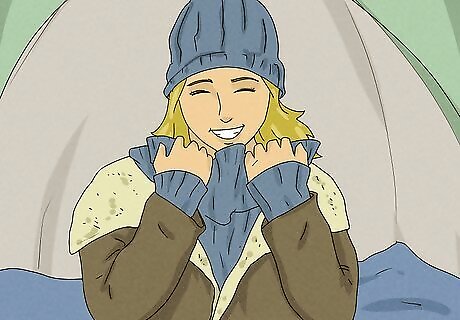
Wear loose-fitting, comfortable layers of wool, pile, or fleece. Feel free to change what you’re wearing when you get inside, but avoid sleeping in just your underwear. Throw on some comfortable clothes. The warmer you are, the warmer the tent will be. If it’s really cold out, wear a hat, thick socks, gloves, and multiple layers—even when you’re sleeping! If you’re sweating in your clothes, it’s going to actually cool off the tent as that moisture gets into the air. Only wear enough layers to keep you comfortably warm without trapping dead space in your sleeping bag or against your skin.
Sleep on top of a foam pad.
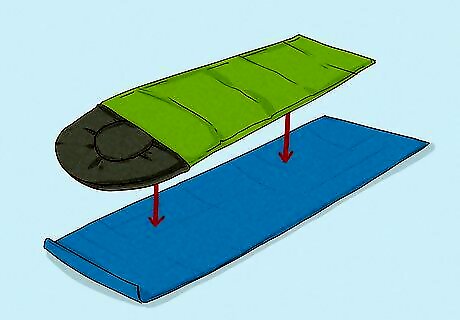
Put a camping foam pad underneath your sleeping bag. The ground underneath your tent will cool the bottom of your sleeping bag if you don’t put a foam pad down, even if the ground is covered in blankets. You may wake up freezing in the middle of the night if there isn’t a big cushion. Bring a foam pad with you on your journey and lay it down on the ground. Put your sleeping bag on top of that before calling it for the night. Foam pads are rated by something called an R-value. The higher the R-value, the better it will be at keeping you warm at night. Some prefer inflatable pads as they tend to provide more warmth than foam pads but are at risk of popping. If you’re already on the campsite and you don’t have a foam pad, layer blankets down on the ground underneath the sleeping bag. It’s not going to be nearly as warm, but it’ll give you some protection.
Sleep close to others.
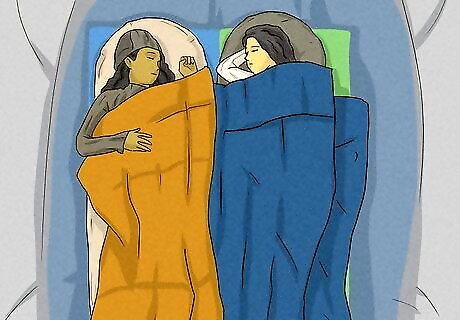
Buddying up by placing sleeping bags together will preserve heat. If you’re camping with your family or significant other, set your sleeping bags as close together as possible. If you aren’t that close with your fellow travelers, consider flipping your sleeping bags around so your head is near their feet and vice versa. It may seem silly, but preserving everybody’s body heat is one of the best ways to keep the tent warm. If you’re camping alone, spread your bags and gear around your sleeping bag. This should block any potential drafts and help insulate the sides of your sleeping bag.
Make a radiant barrier.

Get a Mylar blanket and duct tape it to the ceiling of your tent. Tape it flat so that it rests parallel to the floor and mostly covers the dome-shaped top of the tent. This will create a makeshift radiant barrier. Heat rises, so hanging a heat-trapping blanket and artificially lowering the ceiling is a great way to raise the temperature. A radiant barrier refers to a layer of insulation in a ceiling that reflects and absorbs heat. They’re typically installed in homes, but a mylar blanket in your tent will perform the same basic function. If it isn’t super cold out and you’re doing a pretty good job of bundling up, you may wake up feeling kind of sweaty if you do this.
Sleep with a hot water bottle.
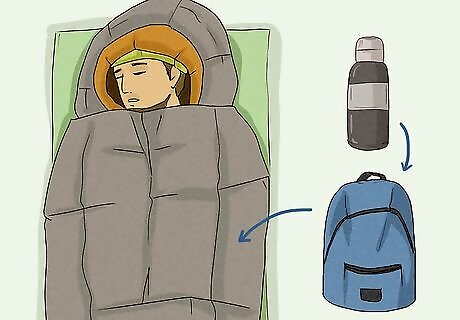
Before you go to bed, boil some water over your backpacking stove. Carefully fill a thermos with the hot water. When you lie down for the night, leave the closed thermos in your bag with you. The heat from the thermos will help you stay warm. If you’re really struggling to stay warm, slide the water bottle between your thighs to keep your body as warm as possible. If the thermos is super hot, wrap it in a thick sock or T-shirt to keep it from burning you. Do not boil your water inside of the tent. Those mini-stoves let off a lot of carbon monoxide, which is poisonous if it can’t get out of the tent.
Knock snow and moisture off the tent.
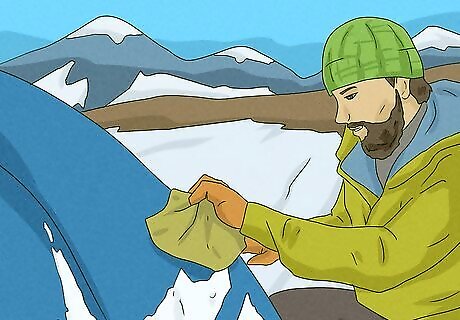
Keep the inside and outside of your tent as dry as possible. If condensation or moisture build up in the fabric, it may freeze. This will dramatically lower the temperature inside of your tent. Use a brush or cloth to wipe the outside of the tent down before you go to bed and after you wake up. If you notice moisture building up inside, wipe it away with a dry cloth. Keeping snow off of the outside of your tent will also make it easier for sunlight to keep the fabric warm. While snow on your tent may help block high winds, it is more likely to cool the tent off than keep it warm.
Get the blood flowing before going inside.
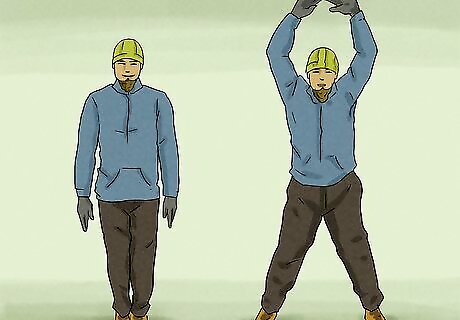
Get the blood flowing before you go inside of the tent. If you head inside before you’ve warmed up at all, you’re going to have a much harder time getting warm. Take a quick jog, do some jumping jacks, or get down and do a few pushups to raise your heart rate every time you go into the tent. It won’t technically raise the temperature inside of the tent, but it will definitely feel much warmer in there! You don’t need to break a sweat or anything. Just do 15-30 seconds of short exercise.
Drink something warm.

A nice cup of hot chocolate or tea will warm you up from the inside. The heat from your cup will also dissipate into the air inside of the tent and keep you feeling cozy and warm. On top of that, it’s just really nice to enjoy a steaming cup of coffee or tea while you’re warming up inside of your tent! This will also warm your hands up. If you hold the cup under your chin, you’ll also get a nice blast of warm air on your face. Never use your backpack stovetop inside of your tent. These things will fill your tent with carbon monoxide if you run it inside.
Pack a winter-safe tent.

All tents are not created equal, so go with the smallest tent you need. Tents are rated for how many seasons they’re appropriate for and If you’re doing any cold-weather camping, a 4-season tent is highly recommended. These tents have multiple layers of nylon that will help keep the heat inside. When it comes to the size of the tent, use the smallest tent necessary. The more empty space there is in your tent, the harder it will be to trap heat inside. Determining how big your tent needs to be should be fairly straightforward. Tents are labelled as 1-person, 2-person, 3-person, etc. Just get a tent that will fit everyone who’s going to be sleeping together. If you have a choice between everyone bringing separate tents and sharing 1 bigger tent, it’s better to have everyone sleep in the same place so long as you’re comfortable sleeping with your fellow travelers. The extra body heat should compensate for the extra space.
Get a thermal sleeping bag.
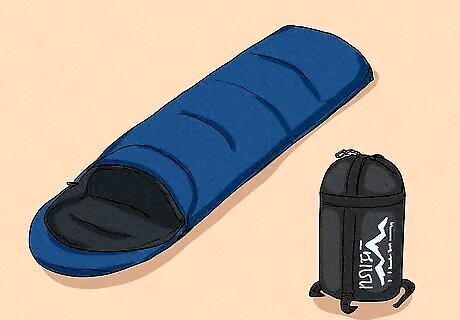
Regular sleeping bags don’t provide a ton of protection in winter weather. You’ll be much warmer if you buy a thermal sleeping bag with a thick lining. This will do a much better job of trapping your body heat at night. Make sure it’s waterproof as well if it’s possible that you’re going to run into snow on your trip. If it’s going to be warmer than 32 °F (0 °C) at night, you can probably get away with a regular sleeping bag. It may be unsafe to skip the winter-proof sleeping bag if it’s freezing out, though. Some sleeping bags offer vapor barriers. These will trap moisture in the sleeping bag. Vapor barriers will give you a ton of warmth inside of the sleeping bag, but you may wake up sweaty and clammy if it isn’t super cold out.



















Comments
0 comment